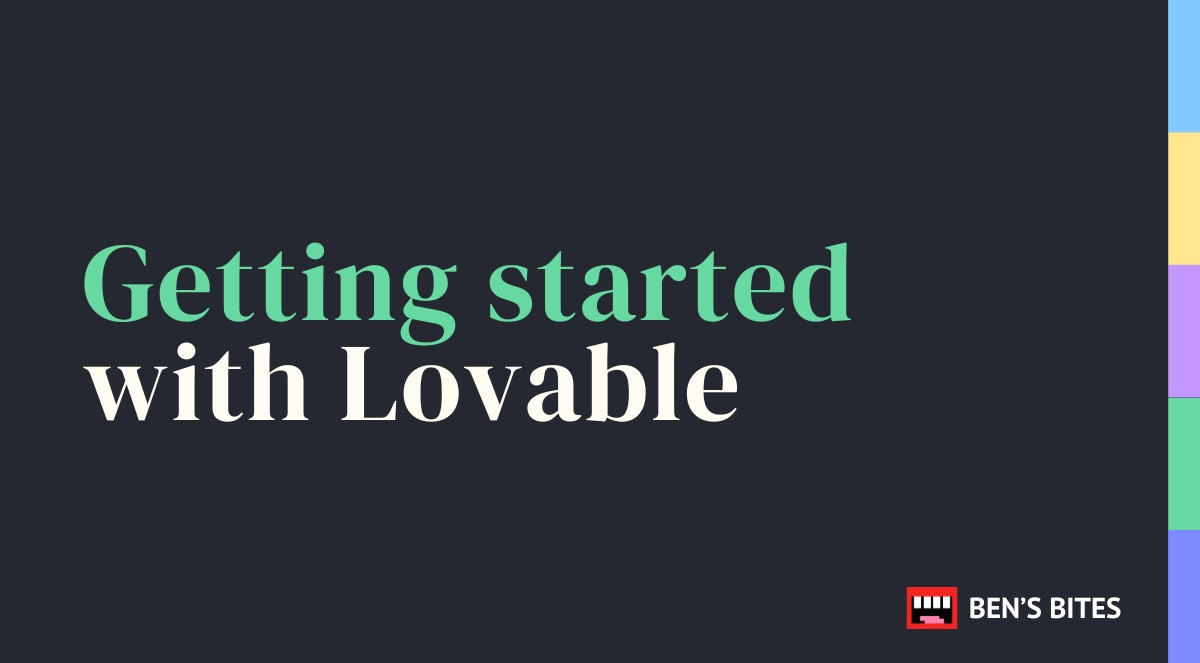Getting started with Lovable: A beginner's guide
Tips and advice for building apps and coding with AI in Lovable.
Think of this guide like a Ben’s Bites snack pack—loaded with tasty tips on how to set up your Lovable projects for success. Whether you’re looking to whip up a quick internal tool or build a production-grade web app, these guidelines will help you make the most of Lovable’s AI-assisted environment.
Let’s get cooking!
1. What is Lovable?
Lovable is an AI-powered platform designed to simplify web application development. Using natural language processing, Lovable turns user prompts into functional apps—perfect for quick prototypes or polished final products.
Lightning-fast development: Lovable claims it’s up to 20 times faster than traditional coding.
No coding needed: Just describe your idea, and Lovable handles the coding using tools like React, Tailwind, and Vite.
Easy refinements: Adjust and improve designs in real-time through prompts or visual editing tools.
2. Building blocks of Lovable
Think of these as the foundation of your app:
Projects and pages - Projects are your overall workspace in Lovable. Each screen or view in your app is a Page. Start with a homepage (or main page) and add more as needed.
Components - Reusable UI elements that keep your app consistent. Examples:
Navigation bars
Footers
Buttons
AI chat - Describe features or changes in plain English—Lovable writes the code for you.
Visual editor - Click on any part of the app preview to tweak text, colors, or layout without code.
Knowledge base - A built-in space to store design rules, requirements, or notes. Lovable references these details to keep your app aligned with your vision.
Integrations - Easily connect to external APIs or libraries (like Chart.js, Stripe, or AI services).
Backend - Set up data storage, user authentication, and more—Lovable handles the heavy lifting so you don’t have to.
3. It all starts with a great app description
Your journey with Lovable begins by creating a new project. The entire process revolves around how you describe your app idea:
Click “New Project” in Lovable.
Enter a detailed description of what you want to build.
For example:
“Create a to-do list app where users can add, edit, and delete tasks, with a clean interface and the ability to save tasks even after closing the browser.”
Provide specific features (e.g., a login page, a button to submit forms).
Mention design preferences, target audience, or any must-have elements to guide Lovable’s AI.
Being precise helps Lovable generate a closer match to your vision, including front-end and back-end code.
4. Prompt engineering tips
Writing effective prompts is key to getting the best results. Keep these guidelines in mind:
Use simple, clear language and avoid technical jargon unless really needed. Imagine you’re explaining the concept of your app to a friend or your mom.
Break down features: specify each part of your app (e.g., “a button to save tasks,” “a login form,” etc.).
Give examples or analogies of apps you like to help Lovable visualize your preferences.-
Whether it’s web or mobile, let the AI know your target platform.
Lovable’s language models interpret these descriptions to generate everything you need under the hood—no coding required!
5. Refining your app with “Select & Edit”
Sometimes the first version of your app that the AI generates isn’t exactly what you had in mind. You can use Select & Edit to refine it:
Pinpoint elements: Click on specific parts of the app preview (like a button or form).
Targeted instructions: Tell Lovable what to change, such as:
“Change the text to ‘Save Task’ and make it green.”
This combination of text-based and visual editing ensures quick, precise tweaks without needing to write code or start over from scratch.
6. Managing projects: saving, sharing, and collaborating
Lovable makes collaboration painless:
Automatic saving: Your work is saved in real-time, so no worries about losing progress.
Share links: Generate shareable links so others can view or edit your project.
Version control: Sync to GitHub for advanced versioning. You can create branches, experiment with features independently, and merge changes later—all within Lovable’s ecosystem.
7. Generate apps from URLs instantly
A time-saving trick straight from Lovable Official (@lovable_dev):
Type "generate.new/[any prompt here]" into your browser to be taken straight to Lovable, where it will start building your project—no need to open the Lovable dashboard first.
Example: generate.new/a weather app with a clean UI
8. JavaScript libraries for extra juice
Want to spice up your app?
Leverage JS libraries: Ask Lovable to add animations, charts, or specialized features.
Example prompt:
“Add a Chart.js graph to show daily stats.”
Multiple design options: Request different styles in a single prompt to sample various “looks” without guesswork.
This is a fantastic shortcut for adding professional touches to your app with minimal effort.
9. Figma integration for designers
Designers, rejoice—Lovable integrates seamlessly with Figma. Here’s what that unlocks for you:
Export mockups: Convert your Figma designs into Lovable, which then generates corresponding React components.
High-fidelity prototypes: Use the Visual Editor in Lovable to tweak text, colors, and layouts directly.
Real interactive apps: Instead of static mockups, you now have a live prototype for testing and stakeholder feedback.
This feature eliminates the usual back-and-forth between designers and developers, accelerating the handoff process.
In summary
Lovable opens the door to swift, user-friendly app creation—perfect for non-developers looking to build functional prototypes or for teams wanting to streamline their workflow.
Now grab your dev tools and get building—the next amazing web app could be just a few prompts away!
This post was created by Amie.



